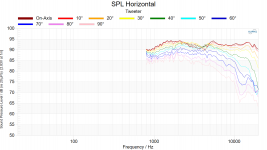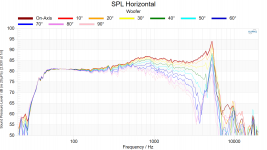AIM:
To design a family of small speakers with that BIG 3-WAY sound that I'm used to, with the aid of the Klippel NFS
Designed for High power handling / low distortion/ low power compression.
Midwoofers: Purifi eXtended x-max drivers.
Tweeters Scan-Speak, SEAS, SB Acoustics or Purifi (TBC)
Cabinets: 1/8, 1/4th, 1/2 or 1 cu foot.
Crossovers optimised for smooth in-room response, and phase coherent at typical listening distances.
Easy to construct for DIYers - use a tweeter you may already have, then build a cabinet you’re comfortable with. Some designs feature centred tweeters, others have offset tweeters. Other cabinets use full 1.5" round overs.
Easy to repair using readily available parts from Purifi and Scan-Speak, SB Acoustics etc.
Designed for free standing (>60cm from front wall ideal). Stretch goals- close to wall, against wall or desktop mounting (no ETA), passive crossovers (no ETA)
Danish Duo Micro. status- Active crossover complete!
Speaker dimensions ~10” x 5” x 8”
featuring Purifi PTT4.0X-04, SBA19mm soft dome tweeter. No waveguide. 1” round over for tweeter.




Danish Duo Mini status- Measurements complete
Dimensions- 12” x 8” x 8”
5.25" Purifi woofer.
-3dB extension 45Hz
Centred tweeter; no roundovers.
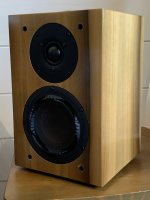
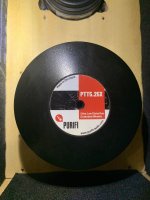
Danish Duo status- Active crossover completed!
PTT 6.5X04-NAA 6.5" aluminium cone midwoofer OR PTT 6.5X04-NFA 6.5" Fibre cone midwoofer
ScanSpeak D2604/8330 1" soft dome tweeter
pictured below- NAA variant.

Crossover optimised for smooth in room response. No smoothing applied*
-3dB/-6/-10dB: 40/35/32Hz.
Aluminium model:

Phase alignment at crossover frequency:

Another way at looking at the above chart, for those unfamiliar, is the reverse null.
At almost 30dB deep, indicates phase coherence at the crossover region, resulting in a speaker that has exceptional imaging.

Polar maps:

Dispersion is exceptionally wide past from +/- 45 degrees horizontally. And +/- 15 degrees vertically.
This means it has a sweet space, not just a sweet spot.
Paper cone model:


Danish Duo Maxi
8” Purifi: in 28L cabinet. status- awaiting cabinet completion.
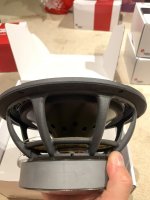
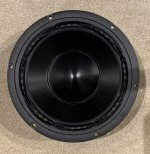
Pictures and specs to come:
Danish Duo XL A high sensitivity, high dynamic range speaker with twin 8" Purifi PTT8.0X-08 + wave-guided tweeter (TBA) - MTM or MMT 2.5way.
status- awaiting tweeter
How to get build plans?
Donate funds to a charity of your choice; then send me the receipt. In exchange I will send you the plans.
100% proceeds Will go to a charity of your choice.
Don’t know which charities to donate to?
Check out www.givewell.org
Just start a Conversation with me to ask me about plans.
PS. Pictures and specs will updated as details evolve
Full disclosure: I sent the Danish Duo cabinet and drivers to @bikinpunk of www.erinsaudiocorner.com to measure on his Klippel NFS. He kindly donated his time, and the use of a $100K USD machine to “measure the drivers for the benefit of the DIY community”. Erin did not ask for any money; nor did he ask for anything in return.
No sponsorship or kickbacks were involved in the design of this family of speakers.
I decided to release the design as “donate-ware”.
Edit: 2024- 02/04/24
PLANS- No Longer Available.
To design a family of small speakers with that BIG 3-WAY sound that I'm used to, with the aid of the Klippel NFS
Designed for High power handling / low distortion/ low power compression.
Midwoofers: Purifi eXtended x-max drivers.
Tweeters Scan-Speak, SEAS, SB Acoustics or Purifi (TBC)
Cabinets: 1/8, 1/4th, 1/2 or 1 cu foot.
Crossovers optimised for smooth in-room response, and phase coherent at typical listening distances.
Easy to construct for DIYers - use a tweeter you may already have, then build a cabinet you’re comfortable with. Some designs feature centred tweeters, others have offset tweeters. Other cabinets use full 1.5" round overs.
Easy to repair using readily available parts from Purifi and Scan-Speak, SB Acoustics etc.
Designed for free standing (>60cm from front wall ideal). Stretch goals- close to wall, against wall or desktop mounting (no ETA), passive crossovers (no ETA)
Danish Duo Micro. status- Active crossover complete!
Speaker dimensions ~10” x 5” x 8”
featuring Purifi PTT4.0X-04, SBA19mm soft dome tweeter. No waveguide. 1” round over for tweeter.
Danish Duo Mini status- Measurements complete
Dimensions- 12” x 8” x 8”
5.25" Purifi woofer.
-3dB extension 45Hz
Centred tweeter; no roundovers.


Danish Duo status- Active crossover completed!
PTT 6.5X04-NAA 6.5" aluminium cone midwoofer OR PTT 6.5X04-NFA 6.5" Fibre cone midwoofer
ScanSpeak D2604/8330 1" soft dome tweeter
pictured below- NAA variant.
Crossover optimised for smooth in room response. No smoothing applied*
-3dB/-6/-10dB: 40/35/32Hz.
Aluminium model:
Phase alignment at crossover frequency:
Another way at looking at the above chart, for those unfamiliar, is the reverse null.
At almost 30dB deep, indicates phase coherence at the crossover region, resulting in a speaker that has exceptional imaging.
Polar maps:
Dispersion is exceptionally wide past from +/- 45 degrees horizontally. And +/- 15 degrees vertically.
This means it has a sweet space, not just a sweet spot.
Paper cone model:
Danish Duo Maxi
8” Purifi: in 28L cabinet. status- awaiting cabinet completion.


Pictures and specs to come:
Danish Duo XL A high sensitivity, high dynamic range speaker with twin 8" Purifi PTT8.0X-08 + wave-guided tweeter (TBA) - MTM or MMT 2.5way.
status- awaiting tweeter
How to get build plans?
Check out www.givewell.org
Just start a Conversation with me to ask me about plans.
PS. Pictures and specs will updated as details evolve
Full disclosure: I sent the Danish Duo cabinet and drivers to @bikinpunk of www.erinsaudiocorner.com to measure on his Klippel NFS. He kindly donated his time, and the use of a $100K USD machine to “measure the drivers for the benefit of the DIY community”. Erin did not ask for any money; nor did he ask for anything in return.
No sponsorship or kickbacks were involved in the design of this family of speakers.
I decided to release the design as “donate-ware”.
Edit: 2024- 02/04/24
PLANS- No Longer Available.
Attachments
Last edited:
impression ?
So far unfortunately all I can say is:
The photos do no justice because the metal cone mid-woofer looks sexier. It’s got that soft but shiny patina semi-gloss that the matches the cabinet.
So as I already favour the look- there’s a clear need for double blinded testing. Of course the cabinets need to be identical.
Here what you have is a symmetrical pair.
I went to play it anyway, but turns out the tweeter was disconnected at the binding post. (Shipping damage). Repaired that and at the same time used opportunity to modify cabinet to accept another tweeter- the metal dome SEAS TAC/GB. The intention has always been for a high value tweeter for DIYers whilst awaiting Purifi’s upcoming ultra low distortion tweeter for the high end market.
So right now crossover needs reworking and fine tuning for this speaker.
The photos do no justice because the metal cone mid-woofer looks sexier. It’s got that soft but shiny patina semi-gloss that the matches the cabinet.
So as I already favour the look- there’s a clear need for double blinded testing. Of course the cabinets need to be identical.
Here what you have is a symmetrical pair.
I went to play it anyway, but turns out the tweeter was disconnected at the binding post. (Shipping damage). Repaired that and at the same time used opportunity to modify cabinet to accept another tweeter- the metal dome SEAS TAC/GB. The intention has always been for a high value tweeter for DIYers whilst awaiting Purifi’s upcoming ultra low distortion tweeter for the high end market.
So right now crossover needs reworking and fine tuning for this speaker.
Really nice looking cabinet. What species of wood is your veneer? It looks similar to oak, but not quite, perhaps... a member of the beech-oak-chestnut family?

Your response for the 6.5 system is impressive. You managed to keep on-axis and listening window relatively flat while holding PIR very flat from 1k to 15k. Overall, the power, PIR and ER curves are super nice over the whole range.
Your response for the 6.5 system is impressive. You managed to keep on-axis and listening window relatively flat while holding PIR very flat from 1k to 15k. Overall, the power, PIR and ER curves are super nice over the whole range.
May I be so bold as to ask the following: we all know by now the Purify surround provides constand Sd with larger excursions, say 12 mm pk-pk. Fine so far: what is there not to like?
But why doesn't the ABR's classic surround muck up matters in such a small enclosure at somewhatk higher SPL's/excursions in an otherwise flawless design?
But why doesn't the ABR's classic surround muck up matters in such a small enclosure at somewhatk higher SPL's/excursions in an otherwise flawless design?
But why doesn't the ABR's classic surround muck up matters in such a small enclosure at somewhatk higher SPL's/excursions in an otherwise flawless design?
First off this is not a flawless design, but thank you for the compliment. It is a balance of trade-offs for the DIY builder.
A Passive radiator's performance is variable. In fact, a port’s performance too, can vary, as shown by @augerpro's ground breaking cabinet construction thread:
https://www.somasonus.net/box-construction-methods
Donate this man a coffee!
But @Boden, you are right to point out that its performance is not as high as a pair of Purifi PTT6.5PR. Purifi’s own pair of PR will enable higher sub-bass output, by the order of 5-6dB, for the same 3% THD limit at 40Hz. The exact figures could be higher. To determine that I would have to use some accepted standard (or variant) of CEA2010, to test the ABR performance.
Last edited:
Well done!
wonderful to have such high quality measurements to work with.
In this enclosure this is what the PTT6.5X-NAA does- without any filter applied.
The midwoofer sits fully flush with the baffle and the rear side of baffle is 45 degree chamfered- the midrange is as flat as a pancake, which is consistent with Yevgeniy's measurement and the Purifi datasheet.
It takes a single notch filter to strike out the ~5KHz metal cone resonance. But interestingly, look how the 10KHz, which is seen on the datasheet, has been suppressed. @lrisbo In my implementation the driver is fully decoupled from the cabinet, and the cabinet is over engineered (braced and damped, the @augerpro cabinet method https://www.somasonus.net/box-construction-methods .In traditional measurements the driver is on a large IEC or quasi IB.
Last edited:
Really nice looking cabinet. What species of wood is your veneer? It looks similar to oak, but not quite, perhaps... a member of the beech-oak-chestnut family?
Hifijim,
It is Australian blackwood, a tree of native south eastern Australia.
https://en.wikipedia.org/wiki/Acacia_melanoxylon
yes indeed, very smooth response. Looks more like my Comsol simulations😎. actually even smoother than Erin’s infinite baffle measurement that has a 1kHz blip. I also wondered about the 10k peak. Looks like you have done an amazing job!In this enclosure this is what the PTT6.5X-NAA does- without any filter applied.
View attachment 1104366
The midwoofer sits fully flush with the baffle and the rear side of baffle is 45 degree chamfered- the midrange is as flat as a pancake, which is consistent with Yevgeniy's measurement and the Purifi datasheet.
It takes a single notch filter to strike out the ~5KHz metal cone resonance. But interestingly, look how the 10KHz, which is seen on the datasheet, has been suppressed. @lrisbo In my implementation the driver is fully decoupled from the cabinet, and the cabinet is over engineered (braced and damped, the @augerpro cabinet method https://www.somasonus.net/box-construction-methods .In traditional measurements the driver is on a large IEC or quasi IB.
yes indeed, very smooth response. Looks more like my Comsol simulations😎. actually even smoother than Erin’s infinite baffle measurement that has a 1kHz blip. I also wondered about the 10k peak. Looks like you have done an amazing job!
@Lars, perhaps you missed my private message/Conversation I sent you about two months ago, where I alerted to you why 1Khz the blip was present...
So your theory is that the 10k resonance which we see in the Purifi data sheet and the hificompass.com data has been suppressed due to the way you mount the driver in the cabinet?
I wonder what the physical mechanism behind this is. If driver mounting suppressed the resonance, that means involved the frame and the baffle. Clearly the 10k resonance has been suppressed, by about -20 dB. I am struggling to envision a kind of plausible 10k resonance between the driver and the baffle... Perhaps something else is going on?
On the other hand, it is more of an academic concern... back in the real world we only need to be concerned up to about 4k, and this driver is stellar.
I wonder what the physical mechanism behind this is. If driver mounting suppressed the resonance, that means involved the frame and the baffle. Clearly the 10k resonance has been suppressed, by about -20 dB. I am struggling to envision a kind of plausible 10k resonance between the driver and the baffle... Perhaps something else is going on?
On the other hand, it is more of an academic concern... back in the real world we only need to be concerned up to about 4k, and this driver is stellar.
So your theory is that the 10k resonance which we see in the Purifi data sheet and the hificompass.com data has been suppressed due to the way you mount the driver in the cabinet?
I wonder what the physical mechanism behind this is. If driver mounting suppressed the resonance, that means involved the frame and the baffle. Clearly the 10k resonance has been suppressed, by about -20 dB. I am struggling to envision a kind of plausible 10k resonance between the driver and the baffle... Perhaps something else is going on?
On the other hand, it is more of an academic concern... back in the real world we only need to be concerned up to about 4k, and this driver is stellar.
That’s right Jim,
Except this is in practice. I haven’t figured out the theory. My statics and dynamics is pretty rusty.
Here are the conditions:
1. Exact same transducer unit, and by that I don’t mean the same model, I mean the exact same transducer that was loaned to Erin by Purifi, as measured here:
https://www.erinsaudiocorner.com/driveunits/purifi_ptt6.5x04-naa-08/
This eliminates sample to sample variability.
2. Exact same measurement device:
Erin’s Klippel Near Field Scanner
That eliminates the measurements device variation.
3. This cabinet.
Last edited:
Very interesting. Conventional wisdom would be that the 5k resonance is a mode 1, and the 10k resonance is a mode 2. If true, most of the 10k signal would be emanating from the center of the cone / dustcap along with an anti-phase signal coming from the cone edge. Therefore, conventional wisdom would discount any contribution from baffle damping or baffle/driver interface damping. Conventional wisdom can sometimes be wrong in a big way.
I have experienced instances where very advanced FEMs showed that landing loads (impact) would propagate only so far into the aircraft structure, only to find out in flight test that the load propagated much further into the structure than we thought possible. So nothing really surprises me about dynamic responses.
I would really like to get @lrisbo 's take on this, assuming he is free to discuss it without giving up trade secrets or proprietary information.
j.
I have experienced instances where very advanced FEMs showed that landing loads (impact) would propagate only so far into the aircraft structure, only to find out in flight test that the load propagated much further into the structure than we thought possible. So nothing really surprises me about dynamic responses.
I would really like to get @lrisbo 's take on this, assuming he is free to discuss it without giving up trade secrets or proprietary information.
j.
- Home
- Loudspeakers
- Multi-Way
- DIY 2-way with complete spinorama / CTA2034A measurements - Purifi and ScanSpeak
